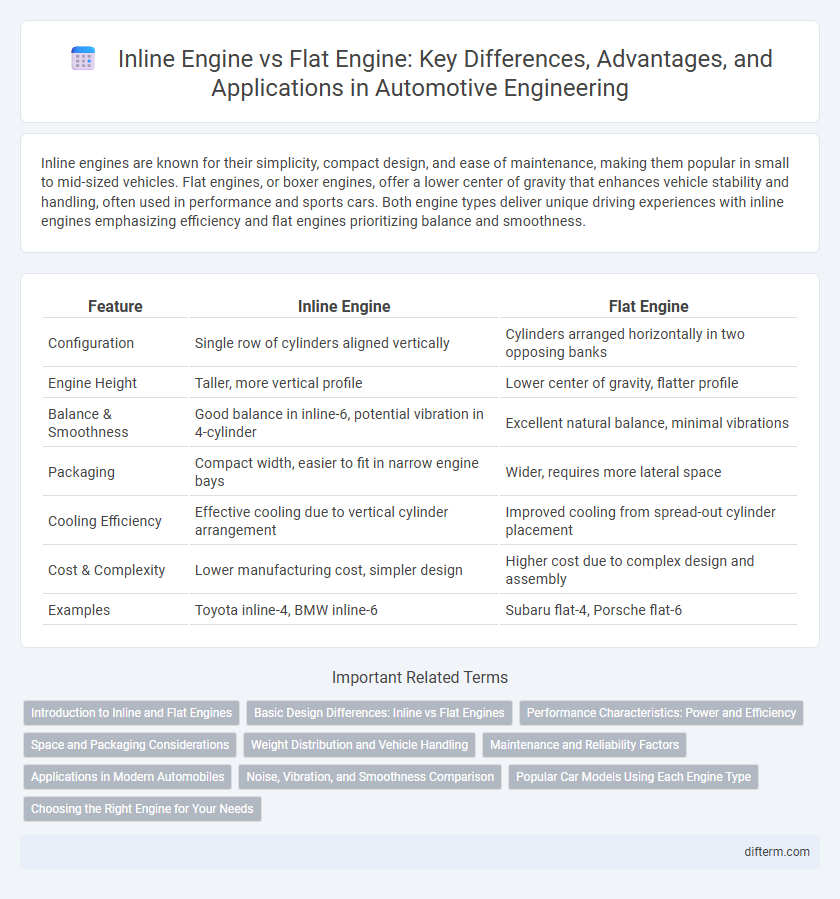Inline engines are known for their simplicity, compact design, and ease of maintenance, making them popular in small to mid-sized vehicles. Flat engines, or boxer engines, offer a lower center of gravity that enhances vehicle stability and handling, often used in performance and sports cars. Both engine types deliver unique driving experiences with inline engines emphasizing efficiency and flat engines prioritizing balance and smoothness.
Table of Comparison
| Feature | Inline Engine | Flat Engine |
|---|---|---|
| Configuration | Single row of cylinders aligned vertically | Cylinders arranged horizontally in two opposing banks |
| Engine Height | Taller, more vertical profile | Lower center of gravity, flatter profile |
| Balance & Smoothness | Good balance in inline-6, potential vibration in 4-cylinder | Excellent natural balance, minimal vibrations |
| Packaging | Compact width, easier to fit in narrow engine bays | Wider, requires more lateral space |
| Cooling Efficiency | Effective cooling due to vertical cylinder arrangement | Improved cooling from spread-out cylinder placement |
| Cost & Complexity | Lower manufacturing cost, simpler design | Higher cost due to complex design and assembly |
| Examples | Toyota inline-4, BMW inline-6 | Subaru flat-4, Porsche flat-6 |
Introduction to Inline and Flat Engines
Inline engines feature cylinders arranged in a single straight line, offering compact design and easier maintenance, commonly used in smaller vehicles for efficient space utilization. Flat engines, or boxer engines, have cylinders laid horizontally in two opposing banks, providing a lower center of gravity and improved stability, often favored in sports and performance cars. Both engine types prioritize balance and power delivery but differ significantly in packaging and vehicle dynamics impact.
Basic Design Differences: Inline vs Flat Engines
Inline engines feature cylinders arranged in a straight line, providing a compact design that simplifies manufacturing and maintenance. Flat engines, also known as boxer engines, have horizontally opposed cylinders, which lower the vehicle's center of gravity and improve balance, enhancing handling performance. The choice between inline and flat engines significantly affects engine packaging, weight distribution, and vehicle dynamics in automotive design.
Performance Characteristics: Power and Efficiency
Inline engines typically offer smoother power delivery and greater fuel efficiency due to their simpler design and reduced internal friction. Flat engines provide a lower center of gravity and improved balance, enhancing vehicle stability and handling performance. Power output varies by configuration and displacement, but flat engines often excel in torque delivery at lower RPMs, benefiting acceleration and drivability.
Space and Packaging Considerations
Inline engines offer a compact design with cylinders arranged in a single row, making them ideal for vehicles with limited engine bay width and simplifying the packaging process. Flat engines, also known as boxer engines, have a lower center of gravity and wider layout, which enhances vehicle stability and handling but requires more lateral space for installation. Space optimization in engine choice directly impacts vehicle design, influencing cabin room, front crumple zones, and overall weight distribution.
Weight Distribution and Vehicle Handling
Inline engines typically offer a more centralized mass, contributing to balanced weight distribution along the vehicle's longitudinal axis, which enhances straight-line stability. Flat engines, with their lower center of gravity due to horizontally opposed cylinders, improve lateral stability and reduce body roll during cornering, resulting in superior vehicle handling on winding roads. Optimizing engine placement based on these characteristics significantly influences the vehicle's dynamic response and overall driving experience.
Maintenance and Reliability Factors
Inline engines typically offer easier maintenance due to their simpler design and fewer moving parts compared to flat engines, which often have a more complex layout. Flat engines provide better balance and lower vibration, enhancing reliability by reducing wear on components, but they may require specialized tools and expertise for servicing. Both engine types benefit from regular maintenance, yet inline engines generally incur lower labor costs and downtime because of their accessibility.
Applications in Modern Automobiles
Inline engines are commonly used in compact and mid-size cars due to their simpler design, which allows for efficient packaging and easier maintenance. Flat engines, or boxer engines, are favored in performance and sports cars by manufacturers like Subaru and Porsche because their low center of gravity enhances vehicle stability and handling. Modern automobiles implement inline engines primarily for fuel efficiency and cost-effectiveness, while flat engines are applied where superior balance and smoother operation are prioritized.
Noise, Vibration, and Smoothness Comparison
Inline engines generate more vibration due to their longer crankshaft and fewer cylinders firing simultaneously, resulting in increased noise and rougher operation. Flat engines, with their horizontally opposed cylinders, offer superior balance and lower vibration levels, enhancing smoothness and reducing engine noise. This inherent design advantage of flat engines leads to quieter operation and improved driving comfort compared to inline configurations.
Popular Car Models Using Each Engine Type
Popular car models featuring inline engines include the BMW 3 Series and Toyota Corolla, known for their smooth operation and compact design. Flat engines, also called boxer engines, power models like the Subaru Outback and Porsche 911, offering a lower center of gravity and improved handling. Both engine types deliver distinct performance benefits tailored to various driving preferences and vehicle architectures.
Choosing the Right Engine for Your Needs
Choosing between an inline engine and a flat engine depends on factors such as vehicle design, performance goals, and space constraints. Inline engines offer a compact, efficient layout ideal for maximizing fuel economy and ease of maintenance, while flat engines provide a lower center of gravity, enhancing stability and handling in performance or sports cars. Evaluating engine configuration alongside intended driving conditions and vehicle type ensures optimal power delivery and overall driving experience.
inline engine vs flat engine Infographic

 difterm.com
difterm.com